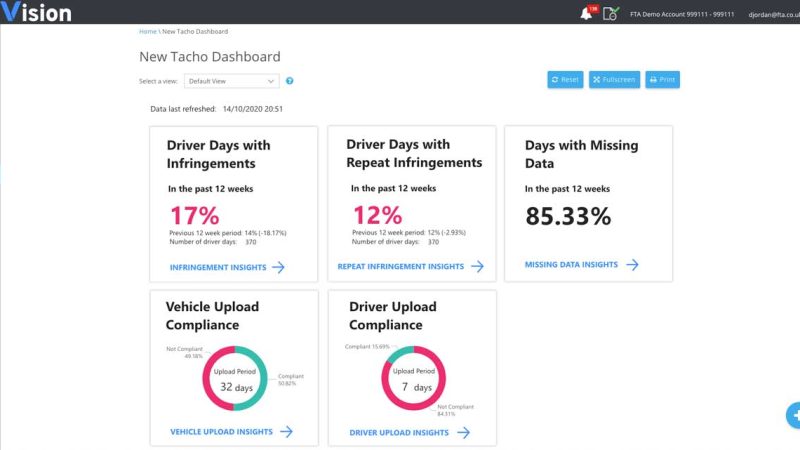Tachographs are vital tools for tracking and recording driving hours, speed, and rest periods of commercial drivers. Their primary purpose is to ensure road safety and that drivers comply with regulations designed to reduce accidents caused by driver fatigue. However, tachograph infringements, which occur when drivers or fleet managers fail to comply with these regulations, can lead to significant penalties, including fines, licence points, or even the suspension of operations. As a fleet manager or driver, it’s crucial to understand tachograph regulations and know how to avoid infringements. In this article, we’ll explore 10 proven ways to help you avoid tachograph infringements and the penalties associated with them, keeping your operations compliant and your business running smoothly.
Understanding Tachograph Infringements and Regulations Thoroughly
To avoid tachograph infringements, it’s essential to have a clear understanding of the rules surrounding tachographs. The regulations governing tachographs, such as the EU Regulation 561/2006, set limits on the number of hours a driver can work, including rest periods and breaks. Ensure that you and your drivers are familiar with these regulations and their updates. Failure to comply with working hour limitations, rest periods, and break times can result in tachograph infringements. Knowing the legal requirements will help you avoid violations and ensure that drivers don’t exceed their driving limits.
Regularly Check Tachograph Calibration to Avoid Infringements
Tachographs, whether analog or digital, need to be calibrated periodically. If the calibration is off, it can lead to inaccurate data being recorded, which could result in tachograph infringements. Regular checks and recalibration of the tachograph are vital to ensure it is functioning correctly and recording accurate driving hours. A properly calibrated tachograph ensures compliance with the legal requirements and prevents errors in the recorded data. Scheduling regular calibration checks with a certified technician will help prevent potential infringements related to faulty equipment.
Ensure Drivers Are Trained on Tachograph Infringements and Proper Usage
In many cases, tachograph infringements occur because drivers are not adequately trained in using the equipment. Drivers should know how to use the tachograph correctly, how to insert the driver card, how to manually input data, and how to manage their driving and rest times. Providing comprehensive tachograph training for drivers will significantly reduce the likelihood of errors, ensuring that they comply with the rules. Training should be part of an ongoing program to keep drivers updated on any changes in regulations and technology.
Monitor Drivers’ Hours and Rest Periods to Prevent Tachograph Infringements
Monitoring driving hours and rest periods is crucial to avoiding tachograph infringements. Fleet managers should regularly monitor the data from the tachographs to ensure that drivers are not exceeding the maximum driving hours or skipping mandatory rest periods.
Using fleet management software that integrates with tachographs can make monitoring easier. These systems track and analyse driving patterns, alerting you to any potential violations, so corrective action can be taken before a penalty occurs.
Implement a Robust Compliance Monitoring System
Having a robust system in place for compliance monitoring is key to avoiding tachograph infringements. This can include automated reporting, regular checks on tachograph data, and internal audits to ensure everything is in order. By identifying potential issues before they become a violation, you can prevent penalties and ensure your fleet remains compliant.
A proactive approach to compliance monitoring will also help keep drivers aware of their responsibilities and encourage them to follow regulations diligently.
Use Digital Tachographs for Enhanced Accuracy
While analog tachographs are still in use, digital tachographs offer more precise data recording, providing a more reliable method of tracking drivers’ hours. Digital tachographs record data in real time and are harder to manipulate, making them more effective at reducing infringements. Switching to digital tachographs, if you haven’t already, ensures greater accuracy in recording driving hours, reducing human error and potential penalties. It also simplifies data storage and retrieval, helping you stay on top of regulatory requirements.
Ensure Proper Handling of Driver Cards
Driver cards are essential for digital tachographs as they store all the driver’s working time data. Drivers must insert their cards at the beginning of each shift and ensure that their cards are used correctly. If a driver forgets to insert their card or fails to use it properly, it can result in tachograph infringements. Fleet managers should regularly check that driver cards are being used correctly, and drivers should be reminded to carry their cards at all times. Keeping backup cards for emergencies is another way to avoid potential issues.
Take Breaks and Rest Periods Seriously
Infringements can often occur when drivers skip required breaks or fail to take rest periods in accordance with the law. According to the regulations, drivers must take a break every four and a half hours of driving, and they must also take daily and weekly rest periods.
Educating drivers about the importance of breaks and rest periods and integrating them into route planning is crucial. Fleets should ensure drivers have adequate time to rest and recharge before continuing their journey, minimising the risk of tachograph infringements.
Investigate Infringements Promptly and Take Corrective Action
If an infringement occurs, it’s vital to investigate the cause and take corrective action quickly. This could mean reviewing tachograph data, speaking with the driver, or reassessing the overall procedures in place. By addressing the root cause of the infringement, whether it’s due to a lack of training, mismanagement of rest periods, or tachograph issues, you can prevent future violations. Ongoing review and improvement of your practices are key to avoiding repeat offences.
Keep Up with Legislative Changes and Technological Advancements
Tachograph regulations are subject to change, and it’s essential to stay updated on new laws, technologies, and best practices. Changes in the law might affect the number of hours drivers are allowed to work, the types of tachographs required, or how data is stored.
Keeping up with changes in regulations and adopting new technologies ensures that you’re always compliant. Regular training, attendance at industry seminars, and subscriptions to relevant updates will help you stay ahead of the curve.
Conclusion
Tachograph infringements can result in severe penalties, including fines, suspension of driving privileges, and even business closures in extreme cases. To avoid these penalties, it’s essential to understand the rules surrounding tachographs, regularly check and maintain your equipment, provide training for your drivers, and implement a compliance monitoring system. By taking proactive measures to ensure proper tachograph usage and adhering to legal regulations, you’ll safeguard your business from costly penalties and contribute to the safety and well-being of everyone on the road.
FAQs
1. What happens if I don’t comply with tachograph regulations?
Non-compliance with tachograph regulations can result in hefty fines, points on a driver’s licence, and even suspension of driving privileges or your commercial operation.
2. How often should tachographs be calibrated?
Tachographs should be calibrated every 24 months to ensure they are recording data accurately. If issues are suspected, more frequent calibration checks may be needed.
3. What are the penalties for tachograph infringements?
Penalties for tachograph infringements can range from fines to a suspension of a driver’s licence or even the temporary closure of a business depending on the severity of the violation.
4. Can tachograph data be used to monitor driver behaviour?
Yes, tachograph data can be used to monitor driving hours, speed, and driving behaviour, helping fleet managers ensure compliance with regulations and improve safety.
5. Do digital tachographs offer more advantages than analog ones?
Yes, digital tachographs provide more accurate data, are harder to tamper with, and offer more convenient ways to store and retrieve data. They help reduce errors and potential infringements.
Also read: Empty Commercial Property Insurance: 10 Powerful Reasons to Protect Your Vacant Property









